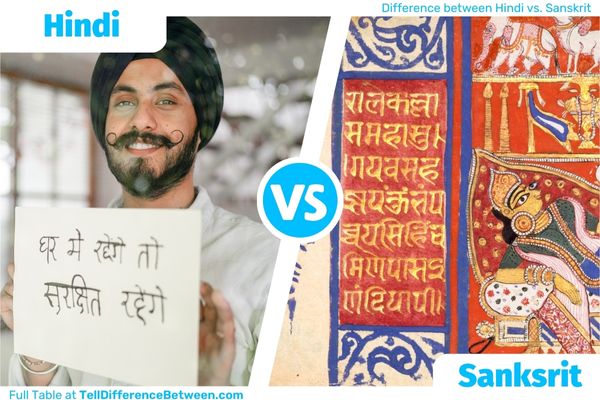Hindi vs. Sanskrit – Differences Between Indo-Aryan Languages

What is the Main Difference Between Hindi and Sanskrit?
The key difference between Hindi and Sanskrit is that Hindi is a modern Indo-Aryan language that has evolved from Sanskrit over centuries and has many influences from other languages, while Sanskrit is a classical language that is no longer spoken as a native language but has had a profound influence on the development of many Indian languages, including Hindi.
Namaste! Welcome to the world of languages where every word has a unique story to tell.
Today, we are going to explore the fascinating differences between two ancient languages – Hindi and Sanskrit. These two languages have been intertwined for centuries, with a rich cultural history that has shaped the way millions of us communicate today.
From poetic hymns to modern-day Bollywood hits, Hindi and Sanskrit have a profound significance that extends beyond just words on paper.

So, get ready to dive into the depths of these two languages and discover what makes them so special!
Differentiating Terms:
Hindi, Sanskrit, Indo-Aryan Languages.
Comparison Table between Hindi vs Sanskrit
Here’s a crisp table highlighting some of the key differences between Hindi and Sanskrit to help your understanding:
| Basis | Hindi | Sanskrit |
|---|---|---|
| Writing System | Devanagari script | Devanagari script |
| Vocabulary | Includes many loanwords from Arabic, Persian, and English | Purely indigenous vocabulary with no foreign loanwords |
| Phonetics | Has a simpler phonetic system with fewer distinct consonant and vowel sounds | Has a more complex phonetic system with a larger number of consonant and vowel sounds |
| Grammatical Structure | Follows a more simplified and streamlined grammatical structure | Has a more complex and detailed grammatical structure with many inflections and cases |
| Usage | Mainly used for spoken and written communication in modern-day India | Not used as a spoken language in contemporary times, but is still used in religious and ritual contexts, and as a basis for many modern languages in the Indian subcontinent |
| Literature | Has a rich and diverse modern literature, with many contemporary authors writing in Hindi | Has a vast and ancient literature, with many of the world’s oldest texts written in Sanskrit |
| Influence | Has been heavily influenced by Persian and Arabic, and to a lesser extent, English | Has influenced many modern languages in the Indian subcontinent, including Hindi |
| Historical Significance | Emerged from the Prakrit languages, and played a crucial role in the Indian independence movement | Is one of the oldest known languages in the world, with a history dating back over 3,000 years |
Understanding Hindi – Usage, Significance, and History
Hindi is one of the official languages of India and is spoken by approximately 500 million people worldwide, primarily in India, Nepal, and Mauritius. It is part of the Indo-Aryan language family and is written in the Devanagari script.
The history of Hindi dates back to the 7th century, when it was first recorded in inscriptions found in the northwestern part of India. Over time, it evolved into several dialects, including Braj Bhasha, Awadhi, and Khari Boli, which eventually became the standard form of Hindi used today.
It is known for its rich and diverse vocabulary, which includes words borrowed from Sanskrit, Persian, Arabic, and English. The language has a complex grammatical system that features gender, tense, and case inflections, and its syntax is subject-object-verb.
Hindi has played a significant role in the cultural and literary history of India, with a vast body of literature written in the language. Hindi literature includes works from many profound authors such as Munshi Premchand, Harivansh Rai Bachchan, and Mahadevi Varma.
In addition to literature, Hindi is also widely used in the media, including films, television shows, and newspapers. Bollywood, the Hindi film industry, is known worldwide for its colorful and extravagant productions, and many Hindi films have gained international acclaim.
Understanding Sanskrit – History, Influence, and Inspiration
Sanskrit is an ancient language that originated in the Indian subcontinent, and is one of the oldest known languages in the world. It is part of the Indo-European language family and has a complex grammar and rich vocabulary that have been instrumental in the development of many other languages.
The earliest form of Sanskrit is known as Vedic Sanskrit, which was used in the hymns and rituals of the ancient Vedic religion. It is believed to have been spoken in the Indian subcontinent around 1500 BCE. Over time, the language evolved into Classical Sanskrit, which became the literary language of ancient India.
Sanskrit is known for its precision and expressive power, and has contributed significantly to the development of Indian literature, philosophy, and religion. The Vedas, Upanishads, and other sacred texts of Hinduism were written in Sanskrit, and it was also used to write works on astronomy, mathematics, medicine, and other fields of knowledge.
The language has a complex grammatical system that includes a wide range of inflections and word forms, making it both challenging and rewarding for learners. It is also noted for its poetic qualities, with intricate meters and sophisticated rhetorical devices.
Sanskrit has influenced the development of many other languages, including modern Indian languages such as Hindi, Bengali, and Marathi as well as languages of neighboring countries like Nepali and Sinhalese. Its influence can also be seen in English, with many words and technical terms borrowed from Sanskrit.
Today, Sanskrit is still used in traditional Hindu rituals and religious ceremonies, and is taught as a language and subject of study in schools and universities around the world. Despite the decline in its use as a spoken language, its rich cultural and intellectual legacy continues to inspire and influence people from all walks of life.
Comparison Video Between Hindi and Sanskrit
Similarities Between Hindi and Sanskrit
- Both Hindi and Sanskrit are Indo-Aryan languages that belong to the same language family. While Hindi is a modern language spoken in India, Sanskrit is an ancient language that has been used for thousands of years.
- Both languages have complex grammatical structures that are based on a system of declensions and conjugations. This means that the endings of words change depending on their function in a sentence.
- Hindi and Sanskrit share many cognate words, which means that they have a common origin. For example, the Hindi word “sab” (meaning “all” or “everyone”) is related to the Sanskrit word “sarva.”
- Both languages have a rich literary tradition and have been used to write a wide range of texts, from religious and philosophical works to poetry and drama.
- Both languages use the Devanagari script, which is a phonetic script that represents sounds rather than letters. This script is used for writing both Hindi and Sanskrit.
- Both languages place a strong emphasis on pronunciation and have a wide range of sounds and tones that are used to distinguish words. For example, Hindi has a system of vowel length that is used to distinguish words like “gaana” (song) and “gana” (group), while Sanskrit has a system of pitch accents that are used to distinguish words.
- Both languages have a significant influence on Indian culture and are widely used in religious and spiritual contexts. Sanskrit is often used in Hinduism, Buddhism, and Jainism, while Hindi is one of the 22 national languages of India and is widely spoken throughout the country.
Main Differences Between Hindi vs Sanskrit
1. Historical Background
Sanskrit is an ancient Proto-Indo-European language that is said to be originated in India over 3,500 years ago. It is considered the mother of all Indian languages and has a rich cultural and religious history. Hindi, on the other hand, is a modern language that evolved from several dialects of the Hindustani language and was standardized in the 19th century.
2. Vocabulary
Sanskrit has a vast vocabulary, with over 200,000 words and complex grammar rules. The language is highly inflected, meaning that words change their forms depending on their function in a sentence. Hindi has a simpler vocabulary and grammar than Sanskrit, with around 50,000 words and less complicated rules. Hindi is also less inflected than Sanskrit, making it easier to learn.
3. Grammar
Sanskrit has a complex and highly organized grammar system that includes eight cases, three genders, and three numbers. In contrast, Hindi has a more simplified grammar system with only six cases and two genders.
4. Script
Hindi uses the Perso-Arabic version of the Devanagari script, which is not used in Sanskrit while Sanskrit has its own unique script called the Devanagari ligatures.
5. Pronunciation
Sanskrit has a more precise and sophisticated system of pronunciation, with a range of sounds that do not exist in Hindi. Hindi, on the other hand, has a simpler system of pronunciation with fewer sounds and less emphasis on accent and stress.
6. Literary Works
Sanskrit has a rich tradition of literature, including epic poems, plays, and philosophical treatises. It has produced some of the greatest works of Indian literature, such as the Vedas, the Mahabharata, and the Ramayana. Hindi, on the other hand, has a more recent literary tradition and has produced great works of modern literature, such as novels, poetry, and plays.
7. Usage
Hindi is widely used as a spoken language in India and is one of the 22 official languages of the country. Sanskrit is mainly used in religious and philosophical texts, as well as in hymns and chants. It is also used in academic and scholarly circles for research and study.
8. Influence
Sanskrit has had a profound influence on the development of Indian culture, philosophy, and religion. Its words and concepts have influenced the development of Hinduism, Buddhism, and Jainism, and its grammar rules have been used as a model for other languages. Hindi, on the other hand, has played a significant role in shaping modern Indian culture and identity, as well as in the development of Bollywood cinema and music.
Wrapping It Up
As we come to the end of our exploration of the fascinating languages of Hindi and Sanskrit, it’s important to reflect on the rich cultural heritage they represent. These languages are not just means of communication, but also windows into the history, beliefs, and traditions of the people who speak them.
Hindi, the official language of India, has a long and diverse history. It is spoken by millions of people in India and around the world, and it has evolved over time to incorporate influences from many different cultures and regions. From Bollywood movies to religious scriptures, Hindi is woven into the fabric of everyday life in India, and it continues to evolve and adapt to the changing needs and interests of its speakers.
Sanskrit, on the other hand, is an ancient language that is often described as the language of the gods. It has a rich literary and religious tradition, and it has influenced many other languages and cultures throughout history. Sanskrit texts have provided insights into fields such as science, philosophy, and spirituality, and they continue to inspire and influence people around the world today.
Despite their many differences, Hindi and Sanskrit share a deep connection to India’s history and culture, and they offer a unique perspective on the world around us.
Author Bio
Rakhi Sharma is an avid reader, street food enthusiast, and the brain behind LookInHindi, the ultimate destination for Hindi readers to refine their language proficiency and literary knowledge.
